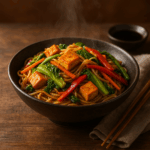For a refreshing alcoholic pairing, consider a crisp Riesling from Germany. Its bright acidity and citrus notes complement the flavors of the stir-fry beautifully. If you prefer a non-alcoholic option, a chilled jasmine green tea with a squeeze of lime is an excellent choice. The floral notes of the tea and the zesty lime enhance the dish's freshness without overpowering it. Both options are easy to prepare and balance the meal perfectly.
Chinese Cabbage and Rice Stick Noodle Stir-Fry with Tofu
Sizzling Chinese Cabbage & Rice Stick Noodle Stir-Fry: A quick, planet-friendly meal packed with crisp veggies, chewy noodles, and tofu—perfect for a flavorful weeknight dinner!
Servings 3
Calories 509kcal
Equipment
- Large wok or deep frying pan
- Knife and cutting board
- measuring cups and spoons
- mixing bowls
- Wooden spoon or spatula
Ingredients
- 300 g Chinese cabbage thinly sliced
- 200 g rice stick noodles
- 200 g firm tofu pressed and cubed
- 1 medium carrot julienned
- 1 red bell pepper thinly sliced
- 2 cloves garlic minced
- 1 tbsp ginger grated
- 2 tbsp soy sauce or tamari for gluten-free
- 1 tbsp vegetarian oyster sauce
- 1 tbsp sesame oil
- 1 tbsp vegetable oil
- 1 tbsp rice vinegar
- 1 tsp sugar
- 1/2 tsp red pepper flakes optional, for heat
- 2 tbsp water
- 1 tbsp cornstarch
- Salt and pepper to taste
- 2 tbsp chopped green onions for garnish
- 1 tbsp sesame seeds for garnish
Instructions
- Prepare the tofu by pressing it to remove excess water, then cut it into small cubes. In a bowl, mix together the soy sauce, oyster sauce, sesame oil, rice vinegar, sugar, red pepper flakes (if using), water, and cornstarch. Add the cubed tofu to the bowl and marinate for at least 10 minutes.
- Cook the rice stick noodles according to package instructions, usually by soaking in hot water for about 5 minutes until softened. Drain and set aside.
- While the noodles are soaking, prepare the vegetables. Thinly slice the Chinese cabbage, julienne the carrot, and thinly slice the red bell pepper. Mince the garlic and grate the ginger.
- Heat the vegetable oil in a large wok or deep frying pan over medium heat. Add the marinated tofu and cook until browned on all sides. Remove the tofu from the pan and set aside.
- In the same pan, add a bit more oil if needed, then add the garlic and ginger. Stir-fry for about 30 seconds until fragrant.
- Add the sliced vegetables (cabbage, carrot, and bell pepper) to the pan and stir-fry for about 3-4 minutes until slightly softened but still crisp.
- Add the cooked rice stick noodles and the cooked tofu back into the pan. Pour any remaining marinade over the noodles and vegetables. Stir-fry for another 2-3 minutes until everything is well combined and heated through.
- Season with salt and pepper to taste.
- Garnish with chopped green onions and sesame seeds before serving.
Notes
Serving suggestions:
Serve hot, garnished with green onions and sesame seeds. You can also serve with some extra soy sauce or chili sauce on the side for those who prefer more flavor or heat.
Substitutes for vegetarian oyster sauce
- Hoisin Sauce: This is a sweet and salty sauce made from soybeans, garlic, vinegar, and spices. It's thicker and sweeter than oyster sauce, so you might want to use a bit less and adjust to taste.
- Soy Sauce with a Touch of Sugar: Mix soy sauce with a bit of sugar or another sweetener to mimic the sweet-salty balance of oyster sauce. Start with 1 tablespoon of soy sauce and 1 teaspoon of sugar for every tablespoon of oyster sauce called for in the recipe.
- Teriyaki Sauce: This is a sweet and savory sauce made from soy sauce, sugar, and other seasonings. It's thinner than oyster sauce but can provide a similar flavor profile.
- Mushroom Sauce: Some stores carry mushroom-based sauces that can be used as a substitute for oyster sauce. These are often made from shiitake mushrooms and have a rich, umami flavor.
Allergens:
- Soybeans (present in soy sauce/tamari and tofu)
- Sesame seeds (present in sesame oil and as a garnish)
- Check the ingredients of your oyster sauce or substitute
Emission Hotspots:
- The rice stick noodles represent the recipe's primary carbon emission hotspot due to rice cultivation's methane-intensive paddy farming
- Shop to home transportation, if a combustion car is used
Sustainability tips:
- Choose seasonal vegetables: Using what's in season not only reduces the carbon footprint but also supports local agriculture and ensures peak freshness.
- Use up veggies: If you have vegetables in your fridge that are nearing their prime (like mushrooms, broccoli, or baby corn), add them to this stir-fry to prevent waste and boost nutrition.
- Walk or bike to the supermarket and farmer's market to cut transportation emissions
- Soak the rice noodles in just enough hot water, then reuse the water for watering plants (after it cools).
- Compost peels and stems: After making your meal, compost any unavoidable food scraps to enrich your soil and reduce landfill impact.
- While your guinea pigs 🐹 will happily eat any remaining carrots, carrot greens and bell peppers, they may not be the biggest fan of cabbage. Use the remaining cabbage to make your own Kimchi, scale the recipe to make use of all cabbage (and freeze the rest) or look for another recipe.
